Text
Coins of the 12 Caesars: Vespasian
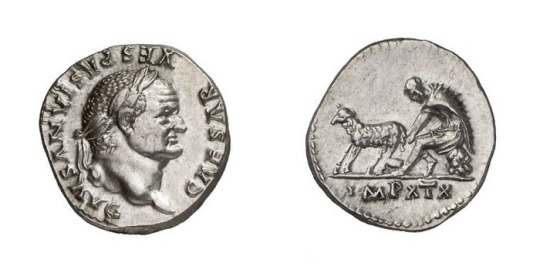
Vespasian denarius, struck 77-78.
Obverse depicts Vespasian facing right.
Reverse depicts a strange goat milking scene, nobody seems to know why this design was used.

Vespasian aureus, Struck at Tarraco in either late 69 or early 70.
Obverse features one of the earliest portraits of Vespasian on coins.
Reverse depicts walking right, holding a spear and a trophy. Legend reads "MARS VLTOR" or "Mars the Avenger". According to the NAC lot description this coin was probably struck after the battle of Cremona in October 69.
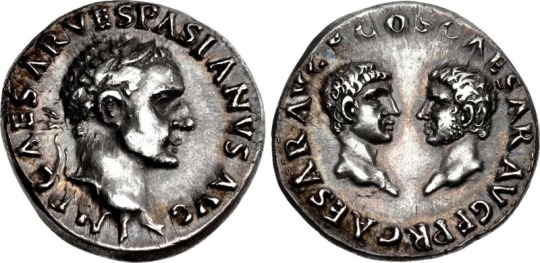
Vespaisan denarius, struck 70.
Obverse depicts a distinctly early portrait of Vespasian.
Reverse depicts his two sons, Domitian on the left and Titus on the right. This dynastic issue is meant to serve as a reminder to the Roman people that the Flavian dynasty was secure with two successors. The empire had just clawed its way out of a brutal civil war and needed a stability.

Vespasian denarius, struck 69-70
Obverse depicts Vespasian facing right.
Reverse depicts a Jewish woman in mourning, behind her stands a Roman trophy. This is probably Vespasian's most famous type and was struck to commemorate the Roman victory in the Jewish war.

Vespasian sestertius, struck 71.
Obverse depicts Vespasian facing right.
Reverse depicts the temple of the Isis, a statue of whom can be seen in the center of the temple. This would mark the first time an Egyptian deity was put on an Imperial era coin, though it is not entirely clear as to why Vespasian chose to issue this type.
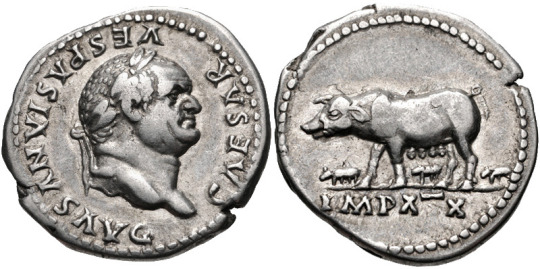
Vespasian denarius, struck 77-78.
Obverse depicts Vespasian facing right.
Reverse depicts a sow with three little piglets.

Vespasian sestertius, struck 71.
Obverse shows a very realistic portrait of Vespasian.
Reverse depicts the goddess Roma, seated on the 7 hills, Romulus and Remus with the wolf are seen to the bottom left of her, the personification of the Tiber to the right of her feet.
#ancient coins#ancient rome#ancient art#ancient history#roman art#roman history#history#classical art#art
3 notes
·
View notes
Text
Coins of the 12 Caesars: Titus
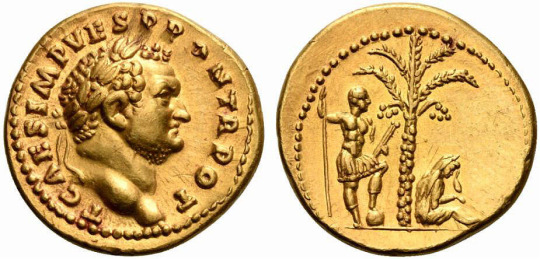
Titus, aureus struck in 71 or 72, during his tenure as Caesar under his father Vespasian.
Obverse depicts Titus facing right.
Legend reads "T CAES IMP VESP PON TR POT"
Reverse is a "Judaea Capta" type, depicting a Jewish woman seated and mourning to the right of a palm tree, to the left is Titus, holding scepter and parazonium with his foot resting on a globe.
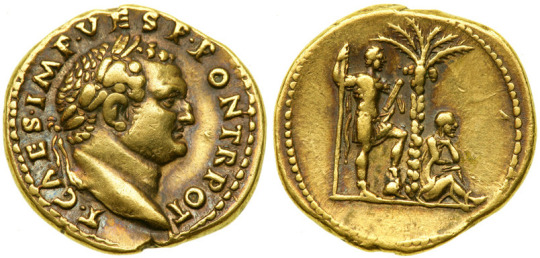
Same type as above, but this one has toning indicative of this coin being a part of the Boscoreale hoard found in Pompeii, with said toning being caused by the heat of the volcanic eruption.
Out of the Flavian dynasty's coinage I'd say Titus just barely takes second to Vespasian in terms of interesting coin types, only because I think Vespasian had the benefit of having more time to strike cool coins.

Sestertius of Titus as Caesar, struck in 72 AD.
Obverse depicts Titus facing right.
Legend reads "T CAESAR VESPASIAN IMP III PON TR POT II COS II
Reverse depicts Titus in a triumphal quadriga holding scepter and olive branch, the side of the quadriga depicts Titus putting his hand on the head of a captive, his other hand holding a palm branch..
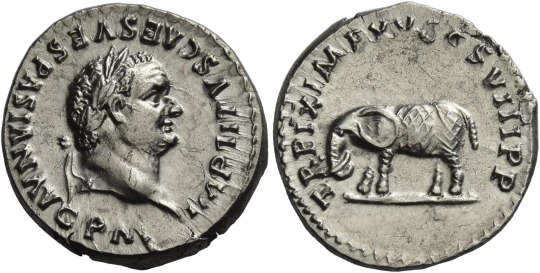
This is an interesting type; the reverse depicts an elephant as a commemoration of the inaugural games held at the Flavian Ampitheater (the colosseum). Elephants such as the one on this coin would have been brought in for entertainment.

The famous Colosseum sestertius, struck between 80 and 81 AD.
Obverse depicts the newly completed colosseum in the center, the Meta Sudans fountain to the left, and a porticoed building to the right.
Reverse depicts Titus seated on a curule chair surrounded by a pile of arms, holding a branch.
Legend reads "IMP T CAES VESP AVG PM TR P P P COS VIII
#ancient coins#ancient rome#ancient art#ancient history#roman art#roman history#roman empire#aureus#history#Titus
18 notes
·
View notes
Text
Coins of the 12 Caesars: Domitian
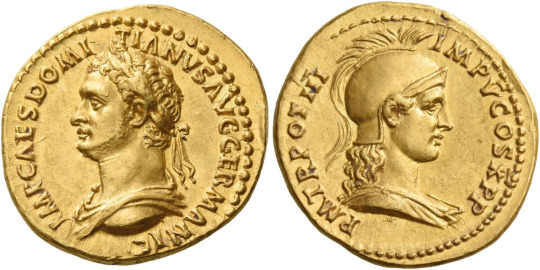
Aureus of Domitian, struck in 84 AD.
Obverse depicts Domitian facing left.
Legend reads IMP CAES DOMITIANVS AVG GERMANIC
Reverse depicts Minerva facing right.
Legend reads PM TR POT III IMP V COS X PP
Domitian isn't the most interesting emperor; I don't think he deserves all the hate from historians since I think on an administrative level, he was pretty solid. Out of the Flavian emperors he is the most overlooked. Vespasian ended the civil war of 69 AD and was a well-liked Emperor, his older brother Titus was beloved by Roman citizens, he opened the colosseum, had to deal with the mess caused by Vesuvius and did some pretty unspeakable things in the Jewish war. And Domitian, well he's mostly remembered for being the ruthless paranoid younger brother who got killed to make way for the ✨5 good emperors✨
(Seriously, if Nerva gets to be grouped in with Trajan and Hadrian the entire Flavian dynasty should be added to make the 8 good emperors)

Aureus of Domitian, struck 84 AD.
Obverse depicts bust of Domitian facing right, legend reads
IMP CAES DOMITIANVS AVG GERMANIC
Reverse depicts Minerva standing left, holding scepter, legend reads
PM TR POT III IMP V COS X PP
Out of all the Roman deities featured on Domitian's coinage struck during his sole reign, Minerva appears the most by far. Mainly because he worshipped the goddess relentlessly, apparently having a shrine to her in his bedroom.
Suetonius writes that just before he was assassinated, Minerva came to him in a dream telling him that she could no longer protect him.
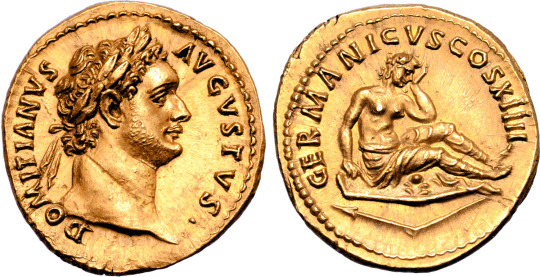
Aureus of Domitian, struck between 88 and 89 AD.
Obverse depicts bust of Domitian facing right, legend reads
DOMITIANVS AVGVSTVS
Reverse depicts a Germanic captive in mourning, resting on a shield with a broken spear below her, legend reads
GERMANICVS COS XIIII
#ancient coins#ancient rome#ancient art#ancient history#roman art#roman history#roman empire#aureus#history#Domitian#gold
22 notes
·
View notes
Text
Egyptian Gods on Christian Era Roman Coins

Constantius II, festival of Isis issue, struck 352-355
Obverse depicts diademed bust of Constantius facing right.
Reverse depicts Anubis, standing left, holding caduceus and sistrum.
The festival of Isis coins are some of the most fascinating pieces struck by Rome in my opinion, especially when taking into consideration that these coins depicting Egyptian deities were still struck under notoriously Christian emperors.

Festival of Isis bronze, 4th century
Obverse depicts bust of Isis facing right, wearing hem-hem crown.
Reverse depicts Harpocrates standing left and holding a cornucopia
The festival itself was held to commemorate the arrival of the ship of Isis that departed from Alexandria and arrived in Rome on March 5th. The last known emperor depicted on a festival of Isis issue is Valentinian II, and the festival would stop being held in the city of Rome around 416.
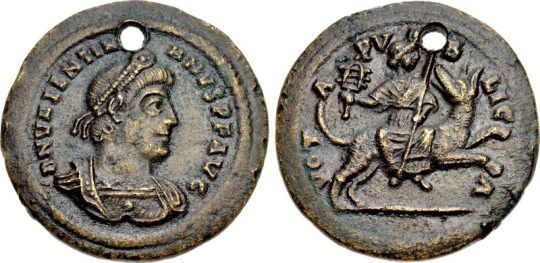
Festival of Isis medallion, Valentinian I, 364-375
Obverse depicts diademed bust of Valentinian I facing right.
Reverse depicts Isis, holding sistrum and scepter, riding on Sothis.

Crispus, Festival of Isis issue, 316-326
Obverse depicts bust of Crispus facing right.
Reverse depicts Isis Pharia on galley, standing to left, head facing right, holding sistrum.

Festival of Isis bronze, 4th century.
Obverse depicts bust of Sol-Serapis facing right.
Reverse depicts winged sphinx advancing right.
8 notes
·
View notes
Text
Hadrian Sestertius engraved by the "Alphaeus Master"

Sestertius of the Emperor Hadrian, struck 132 (?). (i swear to god every time these coins go up for auction these coins have a different date attributed to their striking on the listing).
Obverse legend reads "HADRIANVS AVG COS III PP
Reverse legend reads "PAX AVG"
Among all Roman portraiture of the second century, the coins and medallions attributed to the "Alphaeus Master" stand out as being the best. The engraver is also thought to be a certain "Antoninianos of Aphrodisias" and was possibly a part of Hadrian's inner circle, as Hadrian was a notorious lover of Greek culture.

As far as I know there are only other 4 coins known from these same dies, here are photos of two of the other examples that I was able to find.
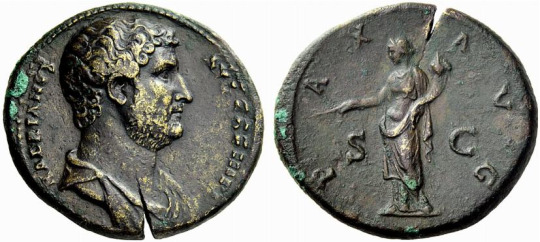

I've taken an interest in the coins attributed to him, and recently been drawing original Sestertii of the other Nerva-Antonine emperors in an attempt to try and replicate the Alphaeus Master's style. I'll be posting those at some point soon.
22 notes
·
View notes
Text
Trajan Decius's Divus Coins

Divus Augustus issue, struck 251, reverse depicts altar.
This commemorative series of coins follows the general theme of Trajan Decius's reign, which was his interest in reviving older conservative Roman values in attempts to help stabilize the state during the shitshow of the third century. The coins were probably struck to harken back to the emperors who ruled over a more stable empire.

Divus Vespasian, struck 251, reverse depicts eagle.
The best parts of these coins is how we get to see long deceased emperors depicted by 3rd century engravers, Vespasian is one of the more boring ones, since his portraits tend to just look like the portraits on the coins struck during his lifetime.

Divus Titus, struck 251, reverse depicts altar.

Divus Nerva, struck 251, reverse depicts altar. Nerva, Hadrian, Marcus Aurelius and Septimius Severus's portraiture in this series are more removed from how they were generally depicted on their coinage.

Divus Trajan, struck 251, reverse depicts eagle.

Divus Hadrian, struck 251, reverse depicts eagle.

Divus Antoninus Pius, struck 251, reverse depicts eagle.

Divus Marcus Aurelius, struck 251, reverse depicts altar. Marcus seems to be a difficult person to engrave on a coin, as his silver portraits vary in style and quality a ton. Decius's engravers didn't quite capture the look of Marcus as we know him, but their take on his portrait is interesting none the less.

Another Divus Marcus Aurelius, struck 251, reverse depicts altar. This portrait is closer to what Marcus's older portraits looked like. This is also a much more common version of the Divus Marcus issue than the one above.

Divus Commodus, struck 251, reverse depicts eagle. If you're wondering why Commodus is grouped here with emperors that are generally considered "good", I don't know either. (it's possible that he's here because Septimius Severus consecrated his memory)

Divus Septimius Severus, struck 251, reverse depicts eagle. This is probably my favorite of the set. For Severus, besides early issues and some coins struck after his death, the majority of his portrait have a very distinct look, so getting a portrait of him in this style with a longer beard like this is really cool.

Divus Severus Alexander, struck 251, reverse depicts altar. While probably the least noteworthy of the emperors here, I can see why he was probably included as an emperor in this series, as his reign is generally considered to be the last stable one before the crisis really got going.
19 notes
·
View notes
Text
The Most Mysterious Emperor to (probably never) Exist.
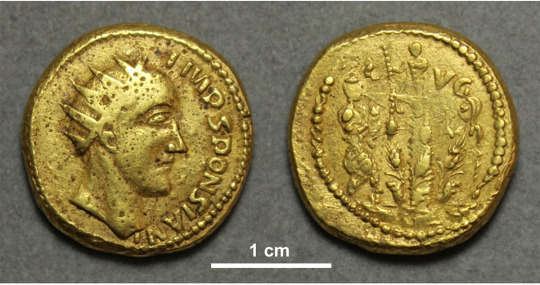
In 1713, The inspector of medals for the holy roman emperor, Carl Gustav Heraeus would note that 8 strange looking gold coins had come into the possession of the Imperial Collection of Vienna. Carl had apparently acquired these coins from the Hapsburg finance minister Johann David von Palm, who in turn had gotten them from a supposed hoard found in Transylvania.
The hoard mainly consisted of an assortment of strange types, ranging from a large gold coin of Gordian III to strange "aurei" of Philip that use a republican obverse, and even a whole gold version of an old Republican denarius.
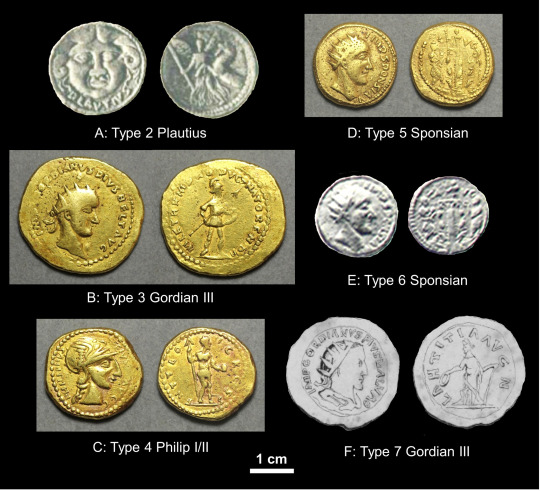
The coins themselves are all very odd, but one type among them stands out for being the strangest of them all, that being the gold coins of the emperor Sponsian, who was unrecorded in history up until the hoard's discovery, and who presumably had all of the hoard coins minted to pay either his soldiers or officials.
Sponsian's gold coins are extremely odd to say the least, and the following is a list of all the details about the coin that differ from the normal imperial issues of the time.
1. The weight is extremely heavy for Roman gold coins, the known Sponsian coins range from weighing 9 to 11 grams. No official Roman or barbarian imitation gold coins weigh that much.
2. The obverse of the Sponsian coin is strange in a few ways.
As noted above, the weight is far too heavy to be an aureus, therefore it is speculated that the coins are of the binio / double aureus denomination due to the radiate crown on Sponsian's head, which on Roman coins is indicative of a double denomination.
It is more likely that they are supposed to be donative coins meant to pay senior officers, although typical donative coins were usually made with spectacular engraving, and the Sponsian coins are just about as far off from that as possible.
The way the legend is lumped to one side of the coin is also never seen on any other official imperial 3rd century issues.
3. The reverse is arguably stranger than the obverse, as it uses a very old Republican design from 135 B.C.
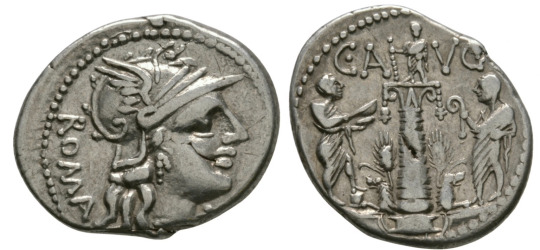
This original republican denarius was meant to commemorate a grain donative and struck by a certain Caius Augurinus, whose name can be seen at the top of the reverse "C AVG".
The use of republican reverses on 3rd century era coinage is unheard of (especially extremely obscure ones such as this), with the Sponsian coins being the only exception. Could Sponsian be calling back to his republican era ancestor Caius?
Not likely.
If these coins are from the 3rd century, the most plausible explanation is that whoever had them engraved for Sponsian had the Republican denarius on hand as a reference and assumed that the "C AVG" on the reverse meant "Caesar Augustus". The Philip coins that were found in the hoard support the theory that the engraver had the Caius Augurinus denarius as a model, since those coins use the obverse of the republican denarius for their design.
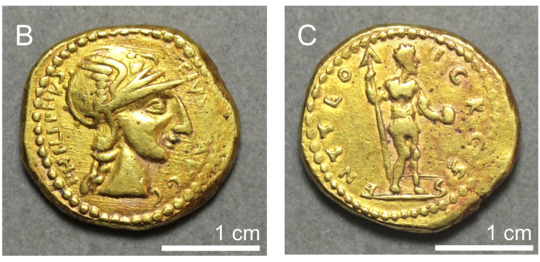
4. The Sponsian coins are undoubtedly cast, which is typically indicative of a fake coin. The problem with the coins being cast is that no 3rd century coins were ever cast, as all official issues were always struck.
There is also no hoard evidence of more Sponsian coins. Another emperor that was proven to exist was Domitian II, who was also brushed off by some numismatists as being a fake (the theory being that his coins were tooled issues of Tetricus) but another example of his coinage was unearthed in a hoard of undoubtedly genuine coins later on, finally proving his existence. If more Sponsian coins are found in a hoard containing genuine coins, it could possibly be evidence that the coins are from antiquity.
(it is noteworthy that the coins of Domitian II are not nearly as weird as Sponsian's coins, and are much easier to accept as real).
We don't know anything about the initial discovery of the Transylvania hoard and we don't even know exactly how many coins were found, but throughout the 18th century the hoard would be dispersed into collections across Europe.
During the period from the hoard's discovery and 2020, many numismatists had the chance to speak on the Sponsian coins. Their theories on the mysterious pieces ranged from the coins being Barbarian imitations, to the coins being blatant 17th century forgeries. But amidst the limited discussion during the years after 1713 surrounding the Sponsian coins, a general aura of mystery still was associated with them.
In 2020, light discussion on the Sponsian popped up again, this time on a Coin discussion forum. At this point Sponsian was very obscure, with only one photo of one of his coins being known at the start of the thread, the same photo was the one being used by Wikipedia on their page about Sponsian.
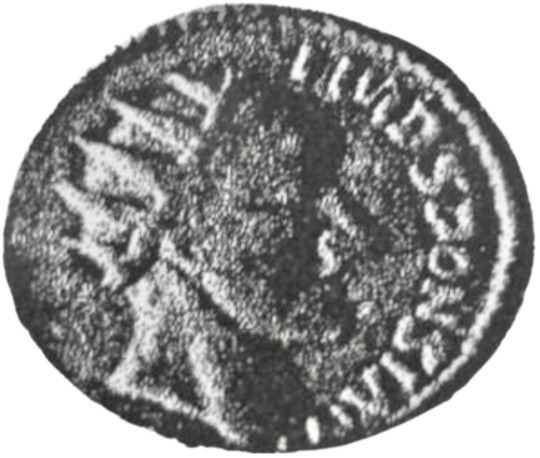
The initial discussion mainly surrounded Sponsian's strange name and trying to find more drawings / photos of the Sponsian coins.
In comes Professor Paul Pearson, who finds more photos of the Sponsian coins, and eventually requests the Hunterian museum to take the photo at the very top of this post. It is my belief that Pearson was inspired to write his famous paper on Sponsian because of his interest in this thread.
Fast forward to 2022, Pearson's paper comes out and proves that the Sponsian coins are ancient and NOT 17th century fakes.
The way Pearson concluded they were real was by analyzing the wear patterns and comparing them to some other genuine gold coins of the period in the same museum. Towards the end of the paper he also theorizes that Sponsian was a rebel in Dacia during the reign of Gallienus, and made these coins to pay his officers.
Alright, now I'm going to need you to forget the narrative that Sponsian ever actually existed.
See, in order for a newly discovered emperor on a roman coin to even remotely be considered as genuine, the coins bearing their name and image at the very least have to follow the specific patterns that other known 3rd century issues follow.
If you're a roman usurper trying to prove legitimacy, one of the first things you do is mint coins bearing your image and name in the typical imperial style to pay your troops. The coins would also have to be similar weights to those of official issue, to make sure they could function properly in the Roman economy.
For example, take the emperor Silbannacus.
He follows the same story as Sponsian in the sense that he was not recorded in any historical record until the discovery of his coins. But instead of being widely criticized by Numismatists for being a fraud, the majority of the Numismatic community is far less skeptical of his coins for the very reason that they followed all the right patterns when it came to Imperial coinage.
There is just way too many weird things going on with the Sponsian coins. All of the right patterns that the Silbannacus and Domitian II coins follow, the Sponsian coins throw out the window.
From the coins being far too heavy, the use of the Republican era reverse, the fact that they're cast. Nothing here adds up.
There are flaws with Pearson's conclusion about the coins being a genuine product from a 3rd century usurper. Although his analysis of the coin's history is solid, the means of determining the coins are from antiquity kind of fall apart when scrutinized.
For one, you can't prove a coin is ancient just because it has scratches on it that are similar to ones on an ancient coin.
There is just no definitive way to date the wear on the Sponsian coins.
Wear can also be easily faked, Pearson even admits this in his paper, as he brings up the forger Carl Wilhelm Becker and how he used iron filings to fake wear on his coins as an example.
It is also important to remember that they were in various collections during the 300 years since they were found, and during that time there is a possibility that they were handled carelessly by numismatists and others due to the fact proper precautions for handling ancient coins were not in place during those years. The wear could've developed from them.
The study done on the earthen deposits is also quite flimsy, there is simply not enough research on deposits in general, and the research conducted on them in Pearson's paper is too surface level to prove much.
We don't know how long those deposits take to form, we don't know if they were formed in the ground or during the coin's stay in the Hunterian collection etc etc.
It's very silly to immediately jump to the conclusion that Sponsian was real just because of these few flimsy points in the face of all of the things alluding to the coins being fake.
During the period after the paper's publication and the media coverage of Sponsian, many rebuttals would be made by numismatists and Roman historians alike, but one series of videos that I followed made by Guy de la Bédoyère covering Sponsian pointed out even more solid evidence against Sponsian.
In the last part of his series (and the only one left public on his yt channel) Guy talks about a book that he recently reread written a bit before the Sponsian hoard's discovery by a scholar named John Evelyn. In one of the chapters pertaining to fakes, Evelyn mentions a hoard of heavy gold forgeries imitating Roman issues discovered during the siege of Bonn in 1673. Later on, while listing off Emperors that were commonly faked, he states "and to these add such as borrow the head of some emperor with some fantastic reverse, or enigmatical inscription, which has no relation to the person, or appertain to some other, or seeming to historize some new and extravagant thing, never heard nor read in any good author before".
(I highly recommend checking out Guy's full video, I'll have it linked at the end)
The Bonn hoard of coins as well as Evelyn's description of fantasy fakes is solid evidence that forgeries similar in style and manufacture of the Sponsian pieces did exist in the 17th and 18th centuries.
Although I'm a firm believer that the coins are fake, at this point this mystery technically isn't 100 percent solved until better research on the earthen deposits is conducted, or if a new hoard of Sponsian coins is found alongside genuine issues.
Sources linked below, highly recommend reading then / watching them if you're interested in Sponsian.
youtube
youtube
3 notes
·
View notes
Text

Medallion of Antinous, favorite of Hadrian. Struck in 134 at Mantineia, Arcadia.
These medallions were commissioned by a man named Vetourios and probably struck for some games that were held at the city of Mantineia that were dedicated to Antinous due to the city's participation in his cult.
The cult of Antinous was created after his death and spread by Hadrian.
10 notes
·
View notes
Text

Nero sestertius struck at Lugdunum in 64 CE.
Reverse depicts a "congiarium" distribution scene, in which the emperor makes donations to the citizens of Rome.
Two citizens can be seen in the center, one handing a tessera to the other, Minerva can be seen in the background. Nero is situated on the reverse seated to the far right, the supervisor of grain standing behind him. Reverse legend reads "CONG II DAT POP"

Nero sestertius struck at Lugdunum in 66 CE.
Reverse depicts another "congiarium" scene. Nero seated in a chair to the far left with one of his officials situated on another platform to his right, handing out congiarium (a donation) to a Roman citizen. The goddesses Libertas and Minerva are seen in the background. Legend reads "CONG I DAT POP".
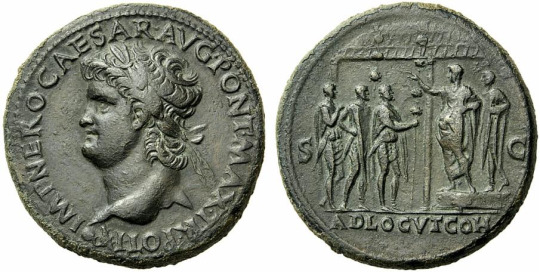
Nero sestertius struck at Lugdunum in 66 CE.
Reverse is an ADLOCVT (addressing the cohorts) type, a reverse that pops up quite a bit on Roman sestertii throughout the years.
Nero is center right on the reverse, raising his hand and addressing three soldiers. Legend reads "ADLOCVT COH".
#ancient coins#roman empire#roman history#roman art#ancient history#ancient art#ancient rome#sestertius
21 notes
·
View notes
Text
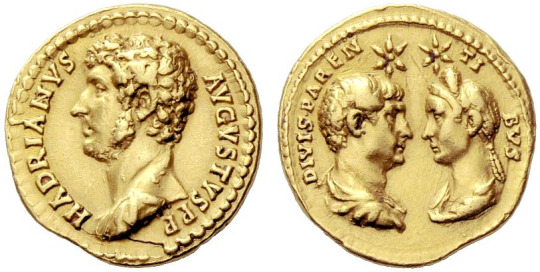
Aureus of Hadrian commemorating the deified Trajan and Plotina, his adoptive parents.
Obverse legend reads "HADRIANVS AVGVSTVS PP"
Reverse legend reads "DIVUS PARENTIBVS"
Hadrian is depicted here in this "youthful" style, an extremely rare and enigmatic portrait type that isn't easily explained. Theories range from it being a portrait-merging of Hadrian and his lover Antinous, a portrait-merging of Hadrian and the Trojan war hero Diomedes, or a commemorative issues struck by Hadrian's successor Antoninus.
24 notes
·
View notes
Text
Portraits of Elagabalus, every year

Denarius of Diadumenian, most notable for not being Elagabalus.
This extremely rare coin was struck between May and July 218 during his father Macrinus's war against Elagabalus and Julia Maesa, and portrays Diadumenian as a full blown emperor (coins of him as Caesar are much more common).
This coin is a prime example of the Severan art style when it came to portraying younger rulers, as even though Diadumenian was not a Severan, his portrait is incredibly similar to that of teenaged Caracalla/Geta and Elagabalus.

Aureus of Elagabalus, 218-219. Reverse depicts Elagabalus flanked by two soldiers, legend reads "FIDES MILITVM"
Portrait resembles the style used for Macrinus.

Aureus of Elagabalus, 219. Reverse depicts Roma seated left.

Aureus of Elagabalus, 220. Reverse shows the conical stone of Emesa, Elagabalus's famous prized rock (its the blob thing behind the eagle, I know, its hard to make it out) riding in a slow quadriga.
At this point we're getting depictions of Elagabalus that are probably closer to what they actually looked like.

Sestertius of Elagabalus, 221, reverse depicts the emperor sacrificing from Patera over altar.

Aureus of Elagabalus, 222. Obverse portrait features bust of Elagabalus laureate, bearded and facing right. Reverse portrays the emperor sacrificing from a patera over an altar to El-Gabal or Sol Invictus.
At this stage of their life Elagabalus was in complete eastern sun god priest mode, as seen on these "SACERDOS" types that are very common for their silver issues.
An interesting piece of this portrait is the weird strand on Elagabalus's head above the V in ANTONINVS. This is usually referred as "The horn", which is most likely supposed to be the penis of a bull.
#ancient coins#ancient rome#ancient art#roman history#roman art#ancient history#aureus#sestertius#elagabalus
28 notes
·
View notes
Text
Interesting Coins of Constantine

Aureus of Augustus, Laurate head of Augustus left on the obverse, Bull on reverse.
The Heifer aureus is an extreme rarity and probably the most artistically beautiful coin ever issued by Augustus.

Aaaand Constantine steals takes inspiration for an obverse design for one of his weird experimental pieces.
We know that Constantine stole referenced the design because the obverse layout is rare enough that its more likely than not that Constantine had one of the Heifer aurei laying around and had the mint workers use it as a model.
The most interesting part of the coin is how the fourth century art style looks on the coin. It's just strange to see the style of the Christian empire on that of a first century coin.

Constantine didnt just have old Roman coins laying around to take inspiration from, he also had some old hellenistic tets too.
The coin above is a 5 Siliquae piece commemorating a dedication event for the city of Constantinople, the personification of which can be seen on the reverse seated. These coins would have been given out to the city elites of the time.

A Hellenistic tetradrachm for reference, the style of coin that Constantine took inspiration from.
23 notes
·
View notes
Text
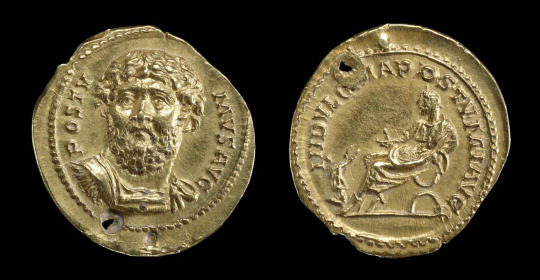
Beautiful Aureus featuring a rare 3/4 Facing bust of Postumus, reverse features Postumus seated, suppliant before him.
71 notes
·
View notes
Text
Medallion of the emperor Probus

Obverse depicts Jugate busts of Sol and Probus, Probus holds transverse spear and a shield decorated with an Adlocutio, or "addressing the troops scene", which itself a design that is used on Roman coinage. Legend reads "IMP C PROBVS INVIC P F AVG"
Struck 276-282
Reverse depicts the three Monetae standing left, holding cornucopiae and scales, Legend reads "MONETA AVG"
Out of the many 3rd century medallions that have this reverse type, this is probably my favorite. There is an argument to be made that Probus had the most diverse and interesting coinage of the third century crisis, only to be topped in my opinion by the separatist emperor Postumus.
9 notes
·
View notes
Text
Coins of the Deified Augustus, 14-268 CE
The most fascinating thing about these types is how Augustus's portrait changes with the engraving style of the period as his portrait is sort of fused with that of the current emperor.

Divus Augustus Dupondius, struck under Tiberius.
A pretty much unaltered portrait of Augustus, something we won't be seeing often when it comes to these coins. Struck 22-23.

Divus Augustus under Tiberius, laureate head of Tiberius on obverse, laureate head of Augustus on reverse with star above. Struck 14-16.

Divus Augustus under Caligula, struck 37. Bare head of Caligula right on obverse, Radiate head of Augustus right on reverse, two stars to each side of bust.

Divus Augustus, struck in Spain(?) during the civil wars that took place between 68 and 69. Radiate head of Augustus on obverse. Pax standing left and holding a caduceus on reverse.
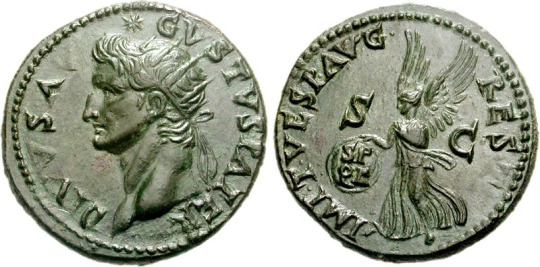
Divus Augustus under Titus (restitution issue that takes the design of that Tiberius Dupondius). Struck 80-81.

Divus Augustus As issued under Nerva (kind of a restitution issue, but not really) Struck 97-98. Eagle perched on thunderbolt on reverse.
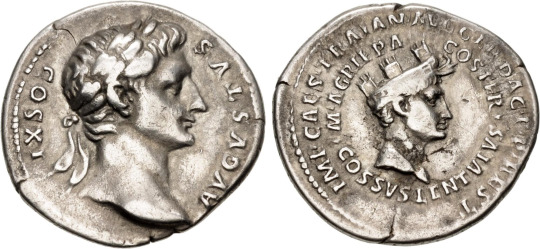
Under Trajan, another restoration issue of one of Augustus's denarii and technically not a Divus issue but I'm still putting here because I like it. Struck 107 or 112-113
Reverse depicts his bestie Agrippa

Cistophoric Tetradrachm struck under Hadrian, 128 (Augustus is literally just a beardless Hadrian here) Reverse depicts Hadrian holding some corn ears.

Skipping forward quite a bit, Divus Augustus Antoninianus issued under Trajan Decius as a part of his "Divus" series of coins. Reverse depicts a lit altar. Struck 249-251.
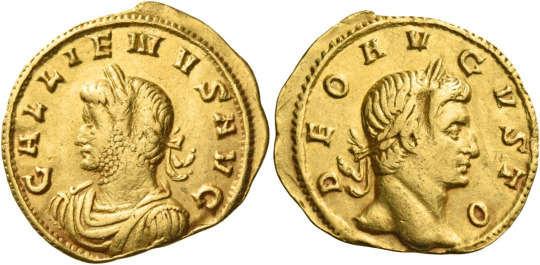
Deo Augusto issue, this one is really interesting as it is *theorized* that this was struck as a way to ask for aid from Augustus the god during Gallienus's disastrous reign. Struck 260-268.
#ancient coins#ancient rome#ancient art#ancient history#roman art#history#roman coin#roman coins#roman empire#roman emperor
78 notes
·
View notes
Text
Coins of Laelian and Marius

Incredibly rare aureus of Laelian, reverse depicts the personification of Hispania. It is presumed from this coin that Laelian belonged to the Ulpii family, a very famous noble family from Hispania.
Laelian, the usurper who tried to usurp a usurper. He led a revolt against Postumus stationed at Moguntiacum (presumably where this coin was minted) for a few months before he was executed by either his own troops or by Postumus's troops after his siege of Moguntiacum.
Laelian wasn't the only Gallic emperor to die at Moguntiacum, as after Postumus's siege was concluded, he forbid his troops from looting the city. This was a terrible decision that proved to be Fatal, and Postumus was killed by his own men in favor of a man named Marius.

Antoninianus of Marius, reverse stolen from Laelians Antoniniani
Marius is a guy who we know pretty much nothing about. We know he probably let Postumus's men sack Moguntiacum and then moved to Trier for a few months before being fucked over by Victorinus.
Is what i would say if we didnt have the completely infallible and historically accurate masterpiece called the "Historia Augusta" to give us the truth about marius.
From the Historia Augusta we learn that Marius was a blacksmith who could knock out someone and thrust back oncoming wagons using only one finger. He rose through the ranks of the gallic army to eventually become emperor after the siege of Moguntiacum, from then he would rule only 3 days before being stabbed by one of his soldiers/smiths who was mad about how he was treated during his time at Marius's workshop. The sword used to kill Marius is said to be one he made himself.

Antoninianus of Marius, with a reverse notably used under Nerva and Pupienus/Balbinus.
#roman history#ancient art#ancient history#ancient coins#laelian#marius#history#classics#roman art#ancient rome#roman usurper
15 notes
·
View notes
Text
Coins of Postumus
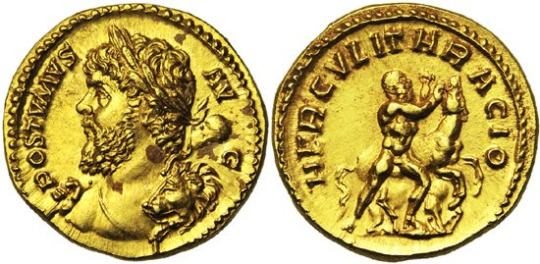
Aureus of Postumus in the guise of Hercules, reverse depicts Hercules grasping a mare.
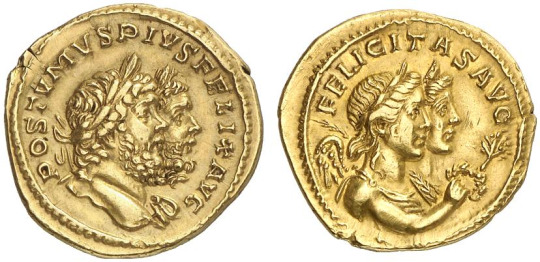
Gold Aureus of Postumus, featuring the busts of Postumus and Hercules on the obverse and Victoria and Felicitas on the reverse.

Aureus featuring helmeted bust of Postumus on the obverse and a trophy with two seated captives beneath on the reverse.
Postumus is widely considered to have some of the most well engraved and unique coins of the third century, and completely surpasses his rival Gallienus in terms of interesting coinage.
44 notes
·
View notes